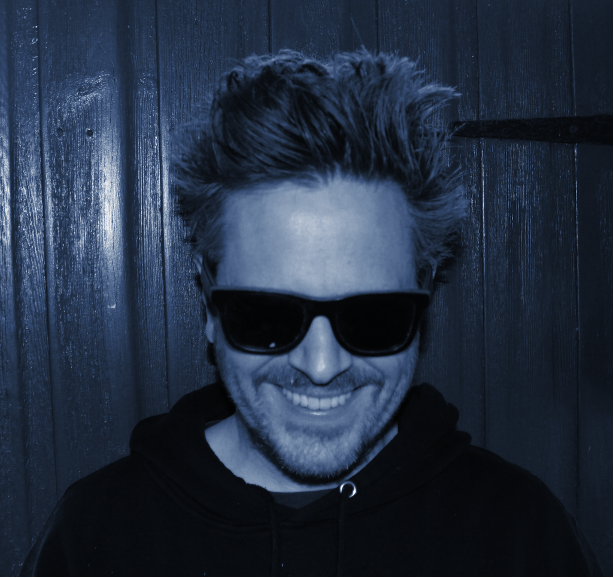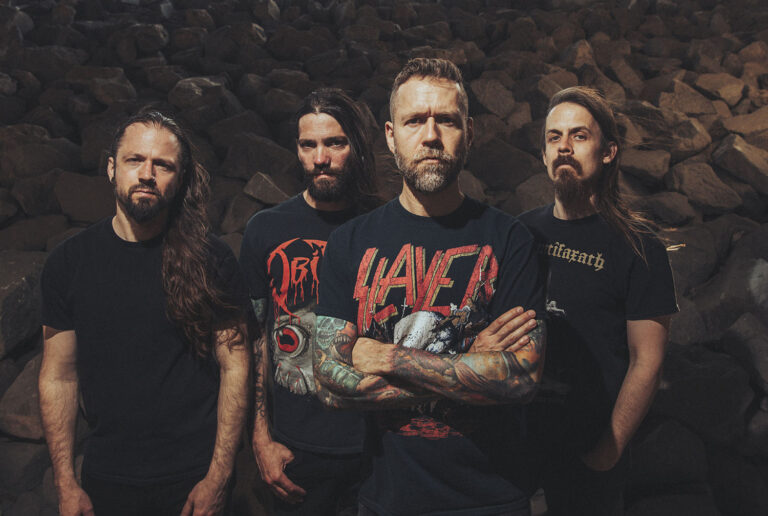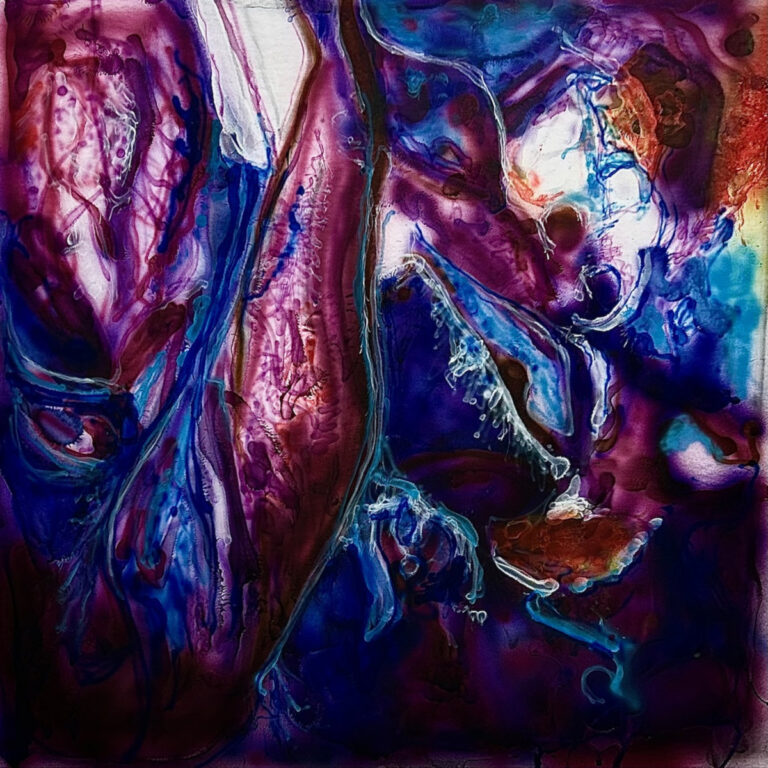Despite the fact that the band has been brewing in the underground for some time, I only came across Sons Of Silver with their excellent EP, Doomsday Noises. Fronted by Peter Argyropoulos, the Sons of Silver (formerly known as Peter RG) rebranded to represent a more collective approach to song-writing and the result, Doomsday Noises, is an absolutely belting collection of songs that harks back to the great alternative surge of the 90s, whilst still maintaining a fresh and exciting edge.
The band, fleshed out by guitarist Kevin Haaland (Skillet), bassist Adam Kury (Candlebox), Drummer Dave Krusen (Pearl Jam) and renowned producer Brina Kabler is a remarkably collegiate unit and, for the interview, it became clear that this group of individuals have bonded on a personal level, as well as around their love of music, often finishing each other’s sentences and trading quips in an easy fashion. It made for a lively and compelling interview as we discussed the roots of the band, the lyrical themes of Doomsday Noises and the advantages of having a producer as part of the line-up…
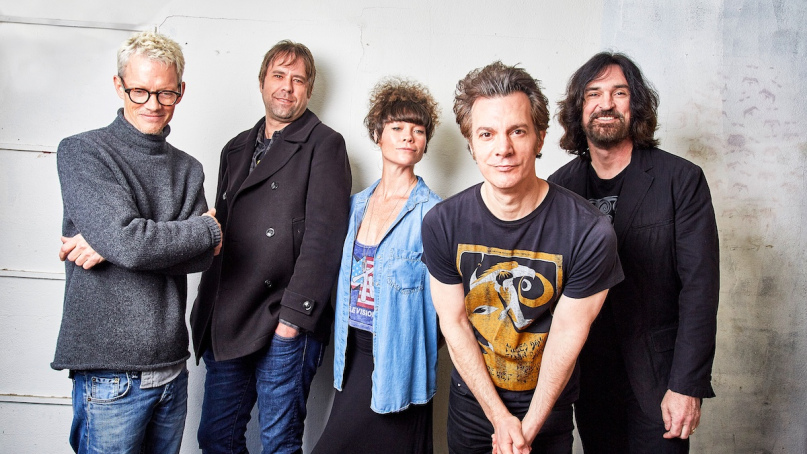
Thank you for making the time to speak with me, I’m not used to speaking with the whole band like this, but the questions are open to whoever wants to answer them, and thank you all for making the time to speak with me.
Peter: No, thank you for taking the time to interview us.
It’s absolutely my pleasure. So, to start with a little background, the band has a long history in which it started with you, Peter, as a singer-songwriter and then evolved, over a couple of EPs and an album, into Sons of Silver, is that right?
Peter: That’s exactly it. It started out as a singer / songwriter thing and it evolved to where we now.
Given that song-writing can be quite a possessive thing and, especially as you started out in that singer / songwriter mould, I was wondering about the process you went through to start writing as a collaborative entity.
Peter: We naturally stumbled into it. As you said a moment ago, it started out as a singer/songwriter kind of thing and I was bringing songs to the band – all these various characters to my left and right – and everyone brought their own take to it. So, it wasn’t like I was going in and saying “hey, Kevin, you play this part” and “Dave, you play this beat”… it wasn’t like that. Everyone brought their own character, so that helps break the ice, so to speak, as far as bringing a song together.
And then, as we went on, especially when we were playing sixty-to-seventy-plus gigs on the road, we spent a lot of time together. You know, you’re sound-checking, you start sharing ideas and then you find yourself in the studio – someone plays a bit of a riff and you all jump in around that. So, one thing led to another and we all started writing together.
For me, frankly, it was very liberating in two ways. One, I didn’t have that load of writing all the songs. It’s a nice challenge at times but, when you’re on the road, it’s not a lot of fun. The other part is how great it is that you make all these things together and you get to share these things with your brothers and your spouse… and truly, we share these things and we can look back at this time when we did these things together and that’s a lot more fun and rewarding then it is to do it all on your own.
You’ve all been involved in a number of well-known bands and then, coming in to this, how did the dynamic evolve, because I guess you have to have a lot of trust in one another to play in that way?
Adam: I agree with Peter, this is way more fun. I’ve been in situations in the past where I did everything myself, or maybe had to go around and tell people how it should be, but this is way more fun.
Kevin: I think it’s kind of exciting to be playing something and maybe you don’t even think too much of what you’re playing and then someone else jumps up and goes “that’s really cool, check out what I can add to this!” And it’s something really cool, that you would never have come up with in a million years, because they’re not you!
So, then you get this other thing, and you just keep adding inspiration to it and, hopefully, in the end you get a song that Peter feels inspired to add lyrics to and it works out. It’s such an easy process for us now because we’ve done it for so long and, if a song doesn’t develop, we just throw it away. We don’t care, there’s nothing precious about what we’re doing, we’re just looking for something that inspires and excites us, and we run with it.
There’s really nothing precious at all.
Peter: I would add to that that we’re looking to have fun. We want something that excites us and if we’re not excited by it, then it’s not fun! And I don’t mean exciting in a raw sense… I mean yes, we’re in a rock band so you’re going to get some of that, but it’s something that just gets you buzzed and you’re looking forward to continuing work on it and you’re looking forward to continuing it live. So, if it doesn’t have all those ingredients, no, we move on quick.
And going back to your question of trust, there’s a tremendous amount of trust. No one cares. We’re all, musically speaking, walking around in front of each other naked all the time… we’re always recording when we’re in the studio, so there’s a free-flowing river of ideas. There are moments that are crash and burn, collectively and individually, and frankly, those are some of the most fun, because those reflect who we are. But that allows us to get things going and come together… like a good stew!
With regards Doomsday Noises, I believe you tracked it live?
Adam: Generally, that’s how we do everything.
Peter: Actually, I’d say it’s always done that way.
Brina: Apart from the one in California – that was the one exception – it was the first month of lockdown and that was a very rare session where everyone did their own individual parts and put it together. Other than that, it’s always everyone in one room coming up with ideas.
I think, with genres like punk or blues, you get so much more energy from that style of recording… there’s a time for separated recording, but that loose vibe you get is really important for playing in that kind of way.
Peter: For sure, can you imagine the Rolling Stones recording remotely?
Kevin: The other thing is, that you know instantly if what everyone’s doing is gelling. We’ve all recorded things many different ways, but I’d take playing live with a drummer, especially if it’s a good drummer, anytime over adding parts later. Generally speaking, we get the keepers in the take, so you don’t then need to analyse it and try to fix things. Also, if you’ve played together you know that the feel is what it is from the start – you’re not trying to superimpose something later on.
Peter: You also know if the guitar part’s on top as well as the vocal because the rhythm section, the guitars and the vocals and the keyboard parts… well actually, Brina’s doing the recording, so she records her parts separately, but she’s making notes as we go along – we get to hear how it’s basically going to sound right from the get go. So, if it isn’t working at the beginning, everything you do after that is just polishing a turd, so you might as well move on to something else.
With this EP, I think you actually recorded quite a few more tracks than you released – so, you obviously spent some time considering how best to get the EP to flow in the way that you wanted – how do you approach that side of things?
Brina: I think some of it fell on lyrics. You know, we had, like you were saying, six more songs from that time… maybe a little bit more, and it came down to Peter having to write lyrics for them. He had quite a lot from the sessions already, so a lot of it was already there, so I should say the final lyrics. So, it came to what inspired him, so you’ve got twelve songs, which ones inspire you the most. And, I think that was a lot of it.
Adam: I think he’s actually asking about how we sequenced the songs…
A bit of both really…
Peter: OK – for me. The recording was done in two phases. The first session was done in late Spring 2019, and the others were recorded in late fall, 2019. And the songs were all written around those times. In the case of the Spring songs, they were written before, and we had the chance to play some of those songs live for a couple of months. So, when we knew that we were going to be releasing an EP in the Spring of 2020, I kind had an idea in my mind over which of the recorded songs were going to be on the Doomsday Noises EP.
So, I knew Read ‘Em Their Rights was going to be on there. I knew World On Fire was going to be on there. It was questionable to me whether or not Deep Division would be on there (which ironically turned out to be the key track for me). So, we knew we wanted to stick to five or six songs and, once we got to the Fall recording, we already had a couple of key songs like Outbreak which, because of the nature of its lyrics has actually been set back a bit… It’s a little bit frustrating for me because it’s a cool song but anyway…
Then, other songs emerged, like Rude Awakening, which had a certain quality to them musically or lyrically, which I thought suited the Read ‘Em Their Rights vibe. So, I wanted to focus on a couple of songs that would flesh out the EP, and I kind of pushed for that, and it kinda naturally went there.
A cool part, I’ll add, is that we have the next EP basically done. We’re just putting some finishing touches to it right now, and we’ve been recording non-stop for several weeks, so it’ll be a nice follow-up to Doomsday Noises.
So, I don’t know if I answered your question, but it felt good to talk about it!
Kevin: Also, my timeline’s a little fuzzy, but…
Peter: Well, you are kind of fuzzy…
Kevin: Exactly – those were all songs that we toured a year ago last Spring. They were in the set. So, yeah, when we’re in the touring cycle (obviously we can’t do it now), any songs that we have that are half way done, we’ll put the ones we like into the set and we’ll go off for a few weeks and tour them, refine them, and then sometimes we’ll keep what we’ve recorded or we might have evolved the feel and take a re-track at it.
So, all of those ones that ended up on that EP, ended up on that tour cycle. And you have to remember that those sets for us, it’s not like we’re headlining two hours a night, we’re doing a forty-five-minute set, so it’s a mix of older stuff and these songs. So, I’m not sure what came first, the Chicken or the egg, but I think, just because those were the songs that were focused on, they kinda went into the EP. It just kind of fell together, honestly.
It obviously really helps to take those songs out live… you mentioned the Stones and I’m a huge Pink Floyd fan, and one of the exciting things is listening to those bands trying out their stuff before it hit the studio…but obviously that’s becoming less of thing with so much social media and people waiving phones in people’s faces, so it’s good that you’re able to do that because I think a lot of artists are a bit gun shy of putting anything new in a a set.
Peter: We’re not!
Kevin: The other thing is that we’re still an up and coming band, so even though there are people who know the music and you get some people who come, knowing the band; a lot of times, you’re on the bill with somebody and most of those people haven’t necessarily heard of you and so, we’re really not locked in to this idea of what we have to play. Hopefully, we’ll have that problem on the next tour where we have to play a certain song because people know it. But we’re lucky – we’ll finish an EP and get it done and on the next tour, we won’t play half of that because we’ve got a new batch of songs. Hopefully we won’t be able to do that in the years to come.
The track on the EP, Rude Awakenings is phenomenal and is driven by very interesting percussion, which has an almost shuffle vibe – was that mapped out in advance or a spontaneous moment in the studio?
Peter: It was all pretty spontaneous. It’s got that rock-a-billy spirit to it and the rhythm track is phenomenal. That was one of those rare occasions, where I actually had a bit of an idea ahead of time for the song and I brought that in… Brina insists she heard me playing it around the house and the guys ran with it from the get go. I think we nailed it within like a take or two. I think we used the second take and it happened so fast that we were like “whoa, how did we get here?” and I remember doing some of the guitar overdubs and Brina, Kevin and I had a lot of fun trading guitar.
It was one of those things where it was like “well, if you’re going to do that, I’m going to do this…”
I will say that, from the get go, that rhythm track – the sounds of the drums –
Kevin: Dave nailed it!
Peter: We had never played that song live, either. So, you know, I’m really looking forward to playing that one It’s going to be a challenge because it’s kind of hard to sing and play for me. But I’m looking forward to it.
You mentioned Read ‘Em Their Rights, which is a cracking song, but as I understand it, the lyric for that came together on stage – is that right?
Peter: The key… the chorus line “read them their rights” that came about on stage. The other lines were in place right from the get go.
It was an interesting start to the song because we were jamming – trading ideas and I started doing some semblance of that first riff and Dave immediately started laying down a beat and we were up and running. Kevin and Adam jumped in, Kevin started playing this bluesy riff and I started doing the “everyone walks a big walk walk…” and were looping on it for fifteen – twenty minutes or even a bit longer, just the verse and pre-chorus and the intro and we didn’t know where to go and that’s where we paused for a moment and Adam was like “the ‘walk walk’ thing is a great place to stop and launch into a chorus” and we paused on it and came up with the chords that we use for the chorus, if I remember right.
At that point I started singing melodies and I had this long melody and that was that. We had to go on the road the next week, so we went on the road and figured we’d play the song and a few shows in, I’d be thinking of ideas and I sang the “read ‘em their rights” chorus line and Kevin came to me between songs and said he liked it. So, I went to the side of the stage and tapped it out on my phone. I liked it. I had had it in my mind for a few days and it was one of those cases where you’re working collectively and you’re maybe feeling sheepish and uncertain about something and then your band mate steps in and says it’s good, that reassures you and you go forward without looking back.
It’s really rare for a band to have their recording engineer working alongside and in the band, so I guess this is more a question for Brina – when you’re playing and rehearsing, are you thinking more with an engineer’s mindset, or is that something you try to separate?
Brina: Well, I guess it depends on circumstances. For example, in rehearsal, when we’re working on stuff earlier on, I would definitely keep a mental note, or take the trusty iPhone out and record things for later. So, I would think in terms of that approach.
But nowadays, we’re always in the studio recording everything. So, I’m actually not in the room doing things from the artist’s viewpoint, I’m in the control room being the engineer. So, I kinda look at it like it’s my responsibility to help them bring their ideas together because most of the ideas are just… they come in and the band don’t remember them so I record everything and then the stuff that’s worth playing back, I play back. We usually record two or maybe three days a week, so we’ll then play back what we did and whatever hits them is whatever we work on.
So, I guess the answer is that I normally wear the engineer hat first and then, if there’s any ideas during the session (keyboard wise or melody wise) I’ll put it on my phone for later on. Then, when I can take my engineer cap off is usually when we lay down the rest of the production. So, we come in, and do the keyboard tracking or whatever – that’s usually where I switch modes to the production side.
But I will say, having been part of the band and knowing what sound we’re going for – it allows us to track closer to what we want the final sound to be. It’s not like we just get a general drum, bass and guitar down… I kinda know what we want, so that really helps, for all of us, I think having someone who can capture it knowing what we’re going for instead of trying to pull that out of the recording later on.
Adam: It’s a big part of why we have jams that are final takes too – it’s a big part of what’s going on.
It’s amazing how much you lose in the heat of the moment…
Peter: Yeah! We don’t have that… we have too many ideas flying around!
Kevin: We’re a little ADD and thank goodness Brina is on top, cataloguing all this stuff. Last week we went out to get another take of a song that we’d already done three takes… and whilst we were getting ready to get that song done, I think we wrote three more songs and she had to organise them. Not complete songs, but definitely things to come back and finish, so she had to organise those and put them into different sessions and bookmark them so we can find them again and hear them.
Peter: We have our own playlist of stuff we can all listen to separately, and it’s a growing selection of songs in idea mode and we can then take stuff out of there. And it does help, because sometimes, with that, you forget a song you’ve worked on> or, we’ll be working on a song and we have a verse and a chorus and we don’t know what to do next, we may have another song that we can bring into that and tie the two together. If you’re just constantly putting stuff pout there that has an energy to it and you’re excited about, and you’re diligent about cataloguing it and managing your catalogue. Everyone talks about inspiration, but you also have to be consistent in your work ethic. You’d be surprised – you can come up with a lot really fast and being in a band situation, you’re working with each other, open to sharing ideas, dancing naked together and so on and so forth… [a brief pause filled with stifled laughs]
Kevin [sotto voce] We’re not *all* that open!
Peter: well… a little too revealing! We just put a poster of you, naked, on the wall…
Kevin: [pointing to Peter and Brina] That’s why the two of you always room share on the road….
Peter: Noooo… [points to Adam and Dave] They do… What goes on in that room???
Kevin: … Yeah, we’re doing enough now that the ideas / the names of what we put on there I have no clue. Even some of the songs we’ve finished, we’ve done so much stuff that I have no clue… it’s like “how does that one go?” As soon as you hear it, it clicks… we’re constantly in this production mode and that’s the mindset and then, as soon as we go on the road, then we’ll switch to the ones we want to play. So, we kind of forget about them (or at least I do) because we’re always looking at the next thing.
Peter: But yeah, we’re good about finishing things. We enjoy things and we enjoy playing together, but it is a commercial project and we want to make a living out of this, so… we make sure we use our time judiciously to explore, to have fun and also to finish the ones we’re most excited about and we do a good job of that.
I know you’ve covered this in previous interviews, but the lyrical content is quite socio-political and, at the same time, is very timely (despite the fact that Outbreak was written sometime before Covid) – so, in a broader sense, what do you like to take inspiration from for the lyrics?
Peter: I’m the lyricist but I’m definitely the mouthpiece in a sense, too, where we talk about socio-political things all the time. When we’re on the road, when we’re in the studio, on the phone together, sharing text messages.
We talk about other things as well – we talk about sports and family life – but, there definitely is a common interest there. There’s a lot of overlap in opinion and there are places where we disagree, but in a cordial way and that makes it into the lyrics – the sentiment, the opinions, even though we shape them in such a way that you probably can’t tell where we stand and… perhaps we don’t know where we stand.
When we’re building the songs, in nearly all cases (except for Read ‘em their rights) the key lyrics are there from the beginning. So, they help drive the song as much as a guitar part would, or a drum or bass line or any melody.
And, you know, for me, I was a political junkie growing up, I was a history major, I almost went to work in Washington D.C. as a brief writer, so it just naturally comes out of me, especially at times like this… I mean god, talk about a lot of ground to choose from. And it’s been going on for a while and that’s why these songs seem really fresh – because they were fixed and written before this stuff happened and, from my opinion, this stuff was all soaking… it was right there at our feet for so long – long before Donald Trump and it’s just we were, in many ways, ploughing our way through it. And now we’ve had a moment of downtime, so we’re all re-assessing (probably reassessing our sanity) and hopefully we move forward in a more positive way.
It’s interesting to take lyrics that are more nuanced because I think it’s more effective to pose questions rather than make didactic statements, especially when looking at a social situation because it makes it more broadly relevant around the world…
Adam: Yeah, there are certain things that ring somewhat true wherever you go. Certain struggles or situations and you’re right, if you don’t get too specific with it then it is open for more people to connect with what you’re talking about.
Peter: No one likes politicians, that’s a universal thing! You have to have a little sympathy for them on that front, they’re the ultimate scapegoat… Politicians and lawyers, right?
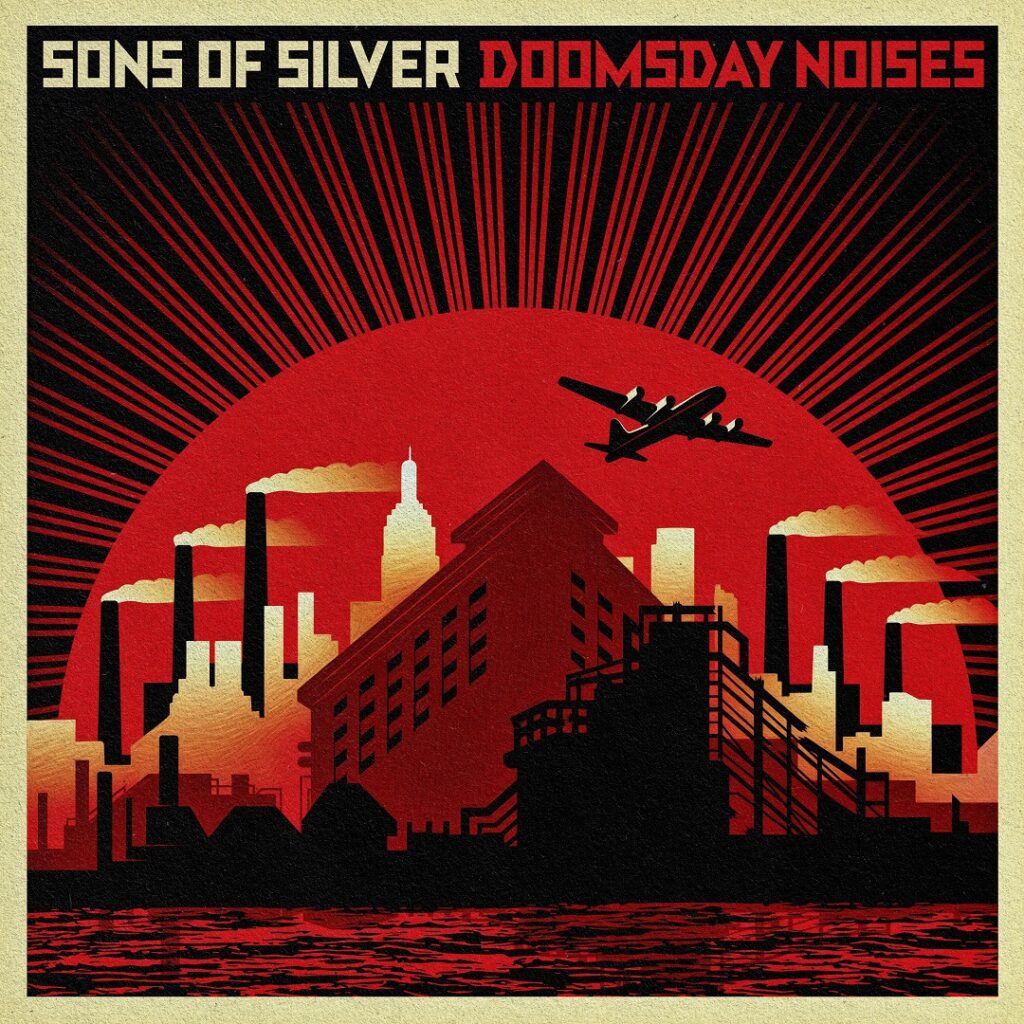
So, my final question, is that I’m a physical media junkie and I don’t think that this EP is out on CD yet, but it’s got great artwork and I was wondering who developed that?
Brina: Thank you! Yeah, it’s a collaborative. Usually it starts with the band talking about things that inspire them and I’ll often put some of my ideas – I use pintrest and have a board. And I’ll sit down with Peter and the guys and put forward the ideas that I think work well with the emotions of the song. And, I’ll get feedback and then, based on that first bouncing of ideas, I’ll put together a more refined palette.
And then we have a video guy and an art guy that we’ve been working with (Donny Phillips does the cover art and Ryan Calvano does the video) and they’re incredible. They’re very talented, they work fast, they’re so easy. So generally, I’ll put together a board, I’ll phone them and I don’t want to tie their hands too much – generally, I’ll give them a few pictures and show them the direction and I say “go for it. Listen to the lyrics and the music, see what inspires you with this palette in mind”. When you find a person to work with who has great talent, great taste and they listen, they’ll often come back with a great first draft and we’ll go from there.
Some of the artwork for Doomsday Noises and some of the singles, they were a little more difficult because we wanted to make sure that it had an impact, but not too much of one, like you were saying, we wanted to maintain the theme of the songs, but we didn’t want to offend anyone at the same time.
Peter: That is not easy to do these days!
Kevin: I think one of the questions you were asking in that as well was physical product, and here I am like a typical band member – I don’t think we’ve made physical product for this yet…
Peter: When we go on the road…
Brina: Yeah, we’ll have all of that…
Peter: We have T Shirts…
Brina: …and cool hats…
Peter: …but the big stuff basically will come when we go on the road. We may end up doing a double-sided EP on vinyl…
Kevin: Vinyl just surpasses CD sales this last week…
Yeah I saw that!
Peter: So, we’ll do it backwards – we’ll do vinyl and then reissue on CD!
And, with that, we say our goodbyes and the band are back to rehearsal. Hopefully, we’ll see much more of Sons of Silver soon, because it’s very clear (both from the strength of the EP and the interview) that they’re just getting started.
Find out more via the band’s website:

